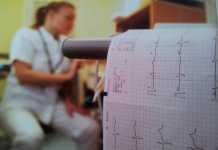November 2003 - Only a tiny percentage of stroke victims who could be saved from death or lifelong disability by the quick delivery of emergency therapy actually get the right treatment in time. But a new study shows there might be a way to fight what stroke experts call one of the biggest travesties in the treatment of the nation's third biggest killer.
The study finds that a focused educational campaign aimed at the public and health professionals nearly quintupled the use of an emergency clot-busting drug in stroke patients in three Texas counties, so that 69 percent of eligible patients got it. And the three-year community campaign produced a sustained increase that wasn't seen at all in two comparable nearby counties where the campaign wasn't carried out.
In the October 13 Archives of Internal Medicine, researchers from the University of Michigan Cardiovascular Center and the University of Texas at Houston report results from the $1.5 million project, funded by the TLL Temple Foundation.
"The campaign had high-impact results in a short time, which clearly shows that we can make dramatic improvements in acute stroke treatment through education," says lead author and U-M Stroke Program director Lewis Morgenstern, M.D., who began the study when he was a stroke neurologist at the U-T Medical School. "The results are especially promising because the same quick deployment needed for the acute therapy drug in this study, tPA, will be essential in any future acute stroke treatments."
Now, Morgenstern and his colleagues hope to see if they can replicate their results in other communities, with further randomized, controlled, prospective studies.
Continue Reading Below ↓↓↓
Since its introduction in 1996, tPA (short for tissue plasminogen activator) has helped tens of thousands of stroke victims who received it within three hours of the onset of their symptoms. By breaking up the blood clots that cause 80 percent of strokes by clogging the brain's blood vessels, tPA reduces the risk of brain damage and death.
Many of the 700,000 Americans who suffer a stroke each year might benefit from acute therapy with drugs such as tPA and others now in development. But the vast majority of patients never get them, often because they don't recognize that they're suffering a stroke, or they don't seek medical help fast enough.
Even if they get to the hospital in time, many other patients fail to receive appropriate acute care because of delays in emergency room care, or because physicians lack the experience, expertise or guidance to decide on acute therapy.
Often, hospitals lack the diagnostic tools and around-the-clock access to medical specialists that can determine the best emergency option for a particular stroke patient. Or, emergency department physicians may decide against giving a certain acute therapy such as tPA after consulting with a patient's primary care physician, who may not have any experience with acute stroke therapy.
So, despite national guidelines to help doctors decide quickly how to diagnose and treat acute stroke, the low rate of optimum care persists � and so does the high death and disability rate from stroke. In addition to killing more than 167,000 Americans each year, stroke disables far more of its victims for life � making it the top cause of disability in the country.
For the Texas study, Morgenstern and his colleagues set out to break down many barriers to acute stroke care through education and training. They measured the effects of their effort by analyzing medical records at the five hospitals in the three Texas counties (Angelina, Shelby and Nagodoches) that were targeted for intervention. In order to be sure the campaign was having an effect, the team also analyzed records at five hospitals in a comparison area: nearby Jefferson and Orange counties.
All five counties are in rural or small-town east Texas, with sizable Hispanic populations, and all had 911 service. All the hospitals had 24-hour emergency departments and could do emergency CT scans, and all but one had a neurologist on staff who could consult with emergency physicians.
Starting in 1998 with the collection of baseline data and the planning of the education campaign, the study continued through mid-2000, when the newly published follow-up data were collected. The team targeted both the public and the health care community at once, using a range of techniques to educate, and to change community norms about reacting to and treating strokes.
The public education campaign emphasized the importance of recognizing stroke symptoms, calling 911 immediately to seek medical attention, asking for acute stroke therapies in the emergency room, and understanding the tremendous benefit of rapid treatment.
Radio and television public service announcements, newspaper articles, brochures, billboards, posters and volunteer training were all used, many in Spanish as well as English. Some of them featured testimonials from local community leaders who had survived strokes through acute care.
Continue Reading Below ↓↓↓
For health professionals, the campaign included the development of protocols for the treatment of stroke that could guide emergency department doctors and emergency medical services staff. Continuing medical education sessions, and mock "stroke codes", were also conducted. Physician newsletters, and newspaper articles highlighting the success of acute treatment in specific local patients, helped shape local medical community norms and reinforce change.
In the first phase of the study, before the education campaign was launched, 424 patients had validated strokes, defined by the researchers to include ischemic stroke, hemorrhagic stroke, transient ischemic attack or subarachnoid hemorrhage. Of them, only 2.2 percent of all ischemic stroke patients in the intervention community, and 14 percent of those deemed eligible for tPA treatment by national guidelines, received tPA. In the comparison communities, the percentages receiving tPA were 0.71 percent of all ischemic stroke patients and 7 percent of eligible patients.
During phase II, when the education campaign was in full swing and 765 patients had strokes, the intervention counties began to see a dramatic rise in tPA use. Among all ischemic stroke patients, 8.65 percent got tPA, and the number was an impressive 52 percent among eligible patients. Meanwhile, 0.86 percent of ischemic and 6 percent of eligible patients in the comparison counties got the treatment.
After the education campaign concluded, the team monitored medical records for six more months, phase III, during which time 238 people had validated strokes.
The effect of the education kept growing, with 11.25 percent of ischemic stroke patients in intervention communities getting tPA, and 69 percent of eligible patients in those areas getting it. In the comparison communities, tPA was given to 1.43 percent of all ischemic stroke patients and 20 percent of eligible patients.
In all, Morgenstern says, the professional education efforts, such as hospital protocols, may have had the most direct impact on acute stroke care. EMTs were especially receptive to the campaign. But he notes that the public really seemed to get the message � and didn't hesitate to let doctors know they wanted appropriate treatments for themselves or for a loved one who was having a stroke.
"Patients came in having seen or heard the PSAs or news stories, and pushed the doctors to consider tPA," he notes. "Then, seeing the drug's effects, doctors who may have been hesitant to use it became advocates themselves. The community education was the impetus to get the ball rolling."
While the public education campaign had an impact on awareness, its effect on the time it took patients to get to the hospital wasn't as clear. The percentage of patients presenting within two hours of the start of their symptoms stayed about the same in both communities, and the median delay time was far beyond 3 hours in both communities and only dipped slightly in the intervention communities.
All in all, Morgenstern says, the study shows that acute stroke care can be improved by tackling the problem from many angles, and using a comprehensive, analytic approach to designing the educational program. "Simply telling people to call 911 quickly isn't enough, but showing them the benefit that rapid treatment had for someone in their community might be," he explains. "Similarly, telling emergency room physicians when to give tPA may not be enough, but if you also show the family physicians how well it has worked in other patients they may be more willing to recommend it when the ER calls."
Most importantly, Morgenstern says, the new results show that a health promotion campaign can make a difference in stroke treatment, and that will be important as new therapies come along to replace or complement tPA. "The future of acute stroke therapy is likely to provide new therapies with very short time windows for treatment, due to the fact that neurons die in a time-dependent fashion. Our results are likely to apply to acute stroke therapy in general, and provide a framework for future interventions of any kind."
In addition to Morgenstern, the research team included U-T Medical School at Houston neurologist James Grotta, M.D.; U-T Medical School at Houston research assistants Lara Staub, M.S., and Mary King, B.S.; and U-T School of Public Health at Houston faculty L. Kay Bartholemew, Ed.D., and Wenyaw Chan, Ph.D.
Reference:
- Archives of Internal Medicine, Oct. 13, 2003
- Results from Phase II of the TLL Temple Foundation study were published in Stroke, Jan. 2002
Source: University of Michigan Health System









